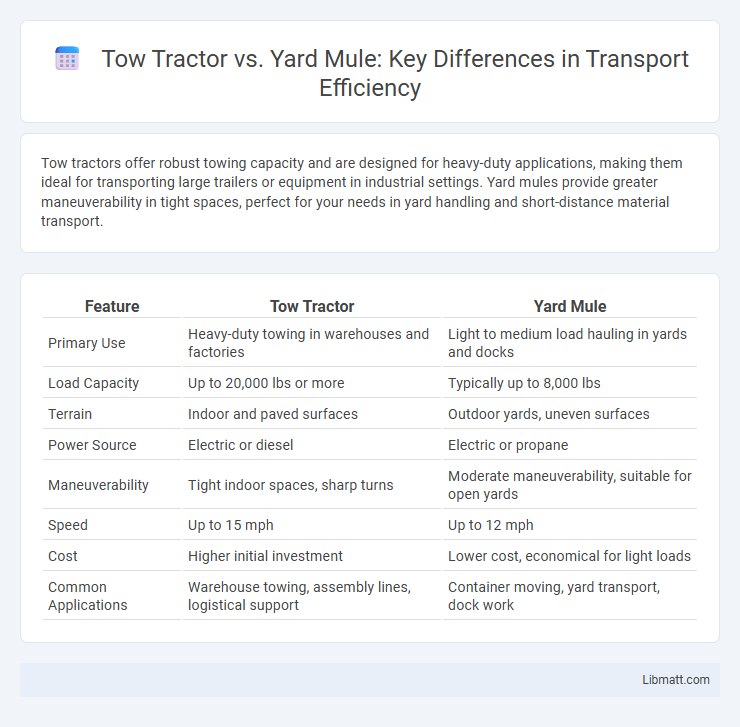Tow tractors offer robust towing capacity and are designed for heavy-duty applications, making them ideal for transporting large trailers or equipment in industrial settings. Yard mules provide greater maneuverability in tight spaces, perfect for your needs in yard handling and short-distance material transport.
Table of Comparison
| Feature | Tow Tractor | Yard Mule |
|---|---|---|
| Primary Use | Heavy-duty towing in warehouses and factories | Light to medium load hauling in yards and docks |
| Load Capacity | Up to 20,000 lbs or more | Typically up to 8,000 lbs |
| Terrain | Indoor and paved surfaces | Outdoor yards, uneven surfaces |
| Power Source | Electric or diesel | Electric or propane |
| Maneuverability | Tight indoor spaces, sharp turns | Moderate maneuverability, suitable for open yards |
| Speed | Up to 15 mph | Up to 12 mph |
| Cost | Higher initial investment | Lower cost, economical for light loads |
| Common Applications | Warehouse towing, assembly lines, logistical support | Container moving, yard transport, dock work |
Introduction to Tow Tractors and Yard Mules
Tow tractors and yard mules are essential material handling vehicles designed for transporting heavy loads over short distances in industrial settings. Tow tractors typically feature higher towing capacities and are commonly used in warehouses, airports, and manufacturing plants to pull trailers or carts efficiently. Yard mules excel in maneuverability and versatility within confined spaces, making them ideal for yard and dock operations where precise handling of materials is required.
Key Differences Between Tow Tractors and Yard Mules
Tow tractors are primarily designed for moving heavy loads over longer distances within industrial and warehouse environments, offering higher horsepower and greater towing capacity compared to yard mules. Yard mules excel in maneuverability and are optimized for short-distance hauling and positioning tasks in tightly confined yard spaces, featuring compact design and enhanced steering mechanisms. The key differences lie in their operational range, load capacity, and design focus, with tow tractors emphasizing power and durability, while yard mules prioritize agility and precision.
Typical Applications in Logistics and Warehousing
Tow tractors are primarily used for transporting heavy loads over long distances within large warehouses and distribution centers, optimizing the movement of pallets, carts, and trailers on factory floors. Yard mules excel in maneuvering trailers and containers in outdoor yard environments, aiding in trailer spotting, repositioning, and loading dock transfers. Both vehicles enhance operational efficiency by reducing manual labor and accelerating material handling workflows in logistics hubs.
Performance and Power Comparison
Tow tractors typically offer higher towing capacities and more robust engines, making them ideal for heavy-duty industrial applications requiring substantial power and consistent performance. Yard mules are designed for lighter loads, providing greater maneuverability and efficiency in confined spaces but with less horsepower and torque compared to tow tractors. Understanding your operational needs ensures you select the right equipment, balancing power with agility for optimal productivity.
Maneuverability and Ease of Operation
Tow tractors typically offer superior maneuverability with tighter turning radii and better control in confined spaces, making them ideal for complex warehouse layouts. Yard mules are designed for ease of operation with user-friendly controls and stability, suited for straightforward towing tasks over longer distances. Understanding your operational environment helps determine whether maneuverability or simplicity should drive your equipment choice.
Safety Features and Considerations
Tow tractors and yard mules both prioritize operator safety but differ in key features. Tow tractors often include enclosed cabins, seat belts, and advanced braking systems to protect the driver during transport of heavy loads, while yard mules emphasize maneuverability with low center of gravity and automatic speed controls to prevent tipping. To ensure your operations stay safe, evaluate the specific safety technologies in each vehicle relative to your workload and environment.
Maintenance Requirements and Durability
Tow tractors typically demand more frequent maintenance due to their powerful engines and heavier load capacities, requiring regular checks of hydraulic systems, brakes, and tires to ensure durability. Yard mules, designed for lighter duty and indoor use, generally feature simpler mechanical components, resulting in lower maintenance needs and longer lifespan under less demanding conditions. Choosing the right equipment for Your operation involves balancing maintenance schedules with durability expectations based on usage intensity and environment.
Cost Analysis and Budget Implications
Tow tractors typically have higher upfront costs compared to yard mules due to their more robust design and greater towing capacity, impacting initial budget allocations significantly. Yard mules, with lower purchase prices and maintenance expenses, offer a cost-effective solution for lighter material handling tasks, making them ideal for tighter budgets. Long-term operational costs favor yard mules when workload demands are moderate, while tow tractors may deliver better value in heavy-duty, high-frequency applications despite higher initial investment.
Choosing the Right Vehicle for Your Facility
Selecting the appropriate vehicle between a tow tractor and a yard mule depends on your facility's load capacity and maneuverability needs. Tow tractors excel in transporting heavy loads across smooth surfaces with high efficiency, while yard mules offer superior agility for navigating tight spaces and uneven terrain. Evaluating operational demands and pathway conditions ensures optimal productivity and safety in material handling.
Future Trends in Material Handling Vehicles
Tow tractors and yard mules are evolving with advancements in automation, electrification, and IoT integration. Future trends in material handling vehicles emphasize autonomous operation, enhanced battery technology, and real-time data analytics to improve efficiency and reduce operational costs. You can expect these innovations to transform logistics and warehouse management by increasing safety and productivity.
tow tractor vs yard mule Infographic

 libmatt.com
libmatt.com